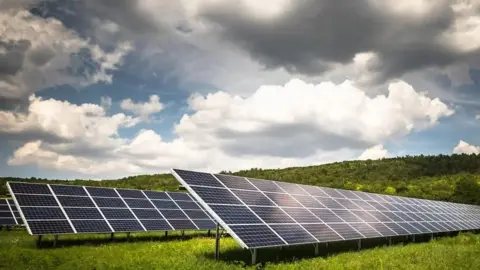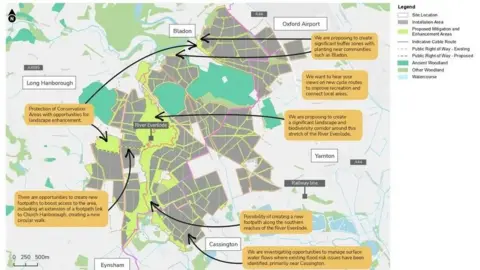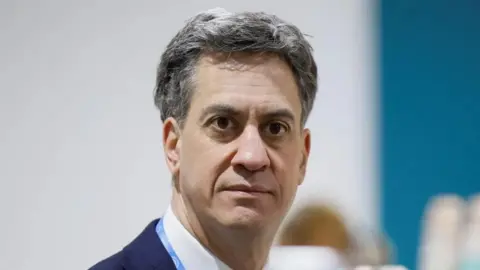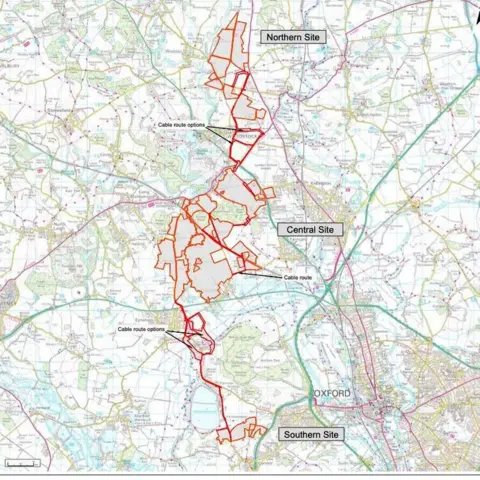Why is the Botley West solar farm so controversial?
 BBC
BBCA plan to create one of the UK's largest solar farms and cover more than 2,000 acres of Oxfordshire countryside with glass panels has split opinion in the county.
The developer behind it says large-scale solar energy is crucial to meet the UK's climate targets, but campaigners argue the scale of the project is "entirely inappropriate" for the rural location.
Solar farms are a key part of the government's plan for more renewable energy. So why is the proposal for Botley West so divisive?
What is the Botley West plan?
 PVDP
PVDPBotley West is a proposed £800m solar farm, covering about 1,000 hectares (2,471 acres) across three areas - north of Woodstock, west of Kidlington and west of Botley.
Blenheim Estates owns 90% of the land within the earmarked site, which it will lease to developer Photo Vault Development Partners (PVDP).
PVDP has said the farm would provide 840MW of electricity and be able to power the equivalent of 330,000 homes.
It would be among the biggest solar farms in the UK. The current largest is the 250-acre Shotwick Solar Park in Flintshire, Wales, which can produce 72.2 megawatts.
Other sites for large-scale solar farms are being explored in the UK, including a 900MW solar farm in south Norfolk.
In July, the government approved a £600m solar farm on the Cambridge-Suffolk border.
Will it help reach climate targets?
 Reuters
ReutersIn November, the government announced new climate change targets, aiming for an 81% cut in emissions by 2035.
Energy Secretary Ed Miliband has said solar power would provide "an abundant source of cleaner, cheaper energy on the mission towards 2030".
PVDP director Mark Owen-Lloyd says Botley West is vital to the UK's climate ambitions.
He says: "Government energy policy is calling for a 250% increase in installed ground-mounted solar.
"We are confident this project will make a significant contribution towards the UK's ambitious solar generation targets."
Dr Sam Mudie, head of energy at the University of Reading, says large solar farms are an "excellent option" but should sit alongside other efforts, such as rooftop solar panels on newbuild houses and solar canopies over car parks.
She says wind farms are a better option in terms of minimising land use, but would come at a higher cost.
Botley West would only represent 1.2% of the UK's target to add 56GW of solar capacity by 2035, says Dr Mudie. "We would need just shy of 100 of these developments to meet the target."
The Department of Energy Security and Net Zero told the BBC: "Even in the most ambitious scenarios, solar would still occupy less than 1% of the UK's agricultural land – less than occupied by golf courses."
What are the concerns?
 PVDP
PVDPFormer MP for Witney Robert Courts said previously it was the "sheer scale" of Botley West that "really causes people such massive concern".
Ian Hudspeth, the former leader of Oxfordshire County Council, who lives in one of the areas included in the proposals, has said the farm would create an "ocean of glass and steel" across the countryside.
But Mr Owen-Lloyd says the solar farm would be hidden in fields and behind hedges, and that people "would not notice it is there".
Farmers have also raised concerns about the impact on the land.
Karl Franklin, who farms near Chipping Norton, says: "I understand the need for renewable energy but I don't think that should be at the cost of food production.
"We need to be as self-sufficient as we can. Putting solar panels [on buildings] first seems a much more sensible solution than taking away food productive land."

Alex Nelms, chair of the National Farmers Union for Oxfordshire, Berkshire and Buckinghamshire, told BBC Radio Oxford: "It's going to affect the viability of [farm] businesses, their ability to produce food, to generate an income and keep a roof over their heads."
But Nick Eyre, from the University of Oxford's Environmental Change Institute, says concerns about the impact on food production are "hugely exaggerated".
"We can produce food much more efficiently, we know how to do that," he says.
"To put it in perspective, 1% of the area [of the UK] is golf courses. I don't hear anybody saying golf courses are a threat to food security."
Mr Eyre said there are currently not enough homes to install the necessary amount of roof solar panels, adding that ground-mounted panels made it easier to connect to the National Grid.
Timescale and decisions
Botley West is considered a Nationally Significant Infrastructure Project, meaning the application must be considered by the government, not local councils.
The Planning Inspectorate advised the developers to justify the project's scale and provide more information on the need for the farm.
While the Department of Energy Security and Net Zero declined to comment on Botley West, it said: "It is important we take people with us and are considering ways to ensure communities who live near new clean energy infrastructure can see the benefits of this."
If approved, PVDP hopes construction of the solar farm will begin in early 2026, with electricity being connected to the National Grid in 2028.
People can register as an interested party to comment on the application until 27 February.
You can follow BBC Oxfordshire on Facebook, X (Twitter), or Instagram.
